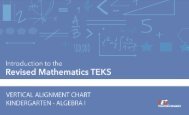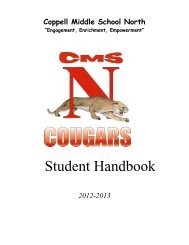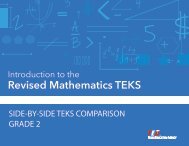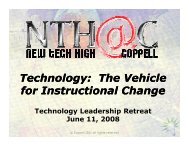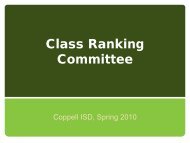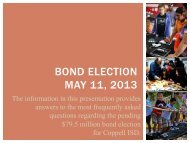SIDE-BY-SIDE TEKS COMPARISON GRADE 3 - Project Share
SIDE-BY-SIDE TEKS COMPARISON GRADE 3 - Project Share
SIDE-BY-SIDE TEKS COMPARISON GRADE 3 - Project Share
Create successful ePaper yourself
Turn your PDF publications into a flip-book with our unique Google optimized e-Paper software.
Grade 3 – MathematicsCurrent <strong>TEKS</strong>: Number, Operation, andQuantitatifve ReasoningRevised <strong>TEKS</strong> (2012) Supporting Information NotesSpecificity has been added about the types ofproblems with the description of one- andtwo-step problems.+3(3)(B) Number, operation, andquantitative reasoning. The student addsand subtracts to solve meaningful problemsinvolving whole numbers.The student is expected to selectaddition or subtraction and use theoperation to solve problems involvingwhole numbers through 999.3(4)(A) Number and operations.Thestudent applies mathematical processstandards to develop and use strategies andmethods for whole number computations inorder to solve problems with efficiency andaccuracy.The student is expected to solve withfluency one-step and two-step problemsinvolving addition and subtraction within1,000 using strategies based on placevalue, properties of operations, and therelationship between addition andsubtraction.Specificity continues with the numberscontained within the problems as “wholenumbers within 1,000.”The revised SE includes specific approaches tosolving the one-step and two-step problems:strategies based on place value, properties ofoperations, and the relationship betweenaddition and subtraction.The one-step problem prompts students toadd numbers such as 237 and 547. If usingstrategies based on place value, a studentmight add the hundreds to get 700, the tensto get 70, and the ones to get 14 and thencombine 700, 70, and 14 to have a sum of784. If using a strategy based on propertiesof operations, a student may consider that237 + 547 is equivalent to 237+(500+47)=(237+500)+47=737+47=784. If using astrategy based on the relationship betweenaddition and subtraction, a student mightsubtract 63 from 547 and add it to 237 tohave 300 and 484 which add to give 784.The revised SE includes fluency.Specificity has been added for the use ofconcrete models and objects. Arrays shouldreflect the combination of equally-sizedgroups of objects.3(4)(D) Number and operations. Thestudent applies mathematical processstandards to develop and use strategies andmethods for whole number computations inorder to solve problems with efficiency andaccuracy.+3(4)(A) Number, operation, andquantitative reasoning. The studentrecognizes and solves problems inmultiplication and division situations.The student is expected to learn andapply multiplication facts through 12 by12 using concrete models and objects.The student is expected to determine thetotal number of objects when equallysizedgroups of objects are combined orarranged in arrays up to 10 by 10.3(4)(E) Number and operations.Thestudent applies mathematical processstandards to develop and use strategies andmethods for whole number computations inorder to solve problems with efficiency andaccuracy.The learning of facts related to 11s and 12s isnot included in the Revised <strong>TEKS</strong> (2012).Specificity has been added about strategiesthat support the learning of multiplicationfacts: repeated addition, equal-sized groups,arrays, area models, equal jumps on anumber line, and skip counting.The student is expected to representmultiplication facts by using a variety ofapproaches such as repeated addition,equal-sized groups, arrays, area models,equal jumps on a number line, and skipcounting.The learning of facts related to 11s and 12s isnot included in the Revised <strong>TEKS</strong> (2012).©2013 Texas Education Agency. All Rights Reserved 2013 Introduction to the Revised Mathematics <strong>TEKS</strong>: Side-by-Side <strong>TEKS</strong> Comparison 7






